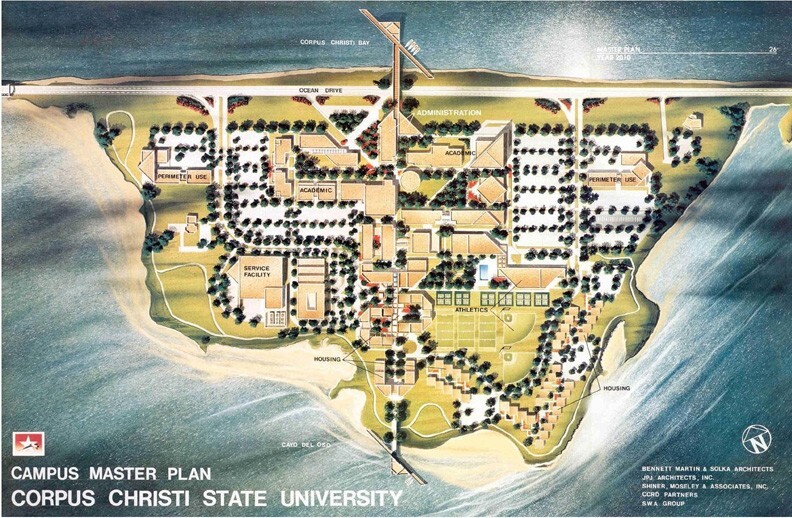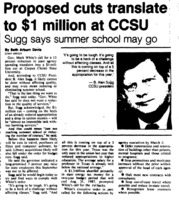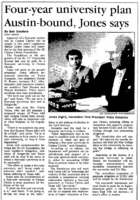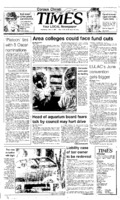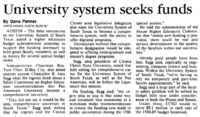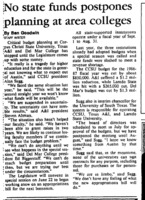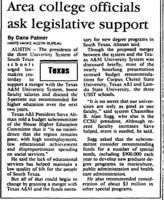The Historical Context of Higher Education Funding at CCSU: 1986-1989
By: Samantha Barrera
Introduction
In the late 1980's, funding for higher education institutions in South Texas faced various challenges and opportunities. Economic factors, state budget constraints, and shifting priorities influenced the financial landscape. Institutions likely grappled with the need to balance quality education against fiscal limitations, requiring strategic decisions and resource allocation. Understanding this historical context can shed light on the complexities of sustaining and advancing higher education in South Texas during this time period presented from 1986-1989. As South Texas institutions were looking to make a significant change that would impact others in the area, the need for funding from the State and private donations to aid in the creation of new programs including graduate and a cooperative doctoral program in Educational Leadership with Texas A&I University, as Corpus Christi State University (CCSU) was also advocating for an expansion to become a four-year institution. The South Texas/Border Initiative (STBI) is a legislative mandate that was initiated in 1989 and provided large sums of funds to nine underserved universities along the Texas-Mexico border, including CCSU (Carales and Duran, 2020)[1].
Before STBI being passed, many institutions were facing state fund budget cuts and were unable to provide graduate and doctoral level programs due to not having enough funding and resources to offer these academic programs, compared to other Texas institutions. As a regional serving institution, Texas A&M University-Corpus Christi (TAMUCC) has also been able to develop regional partnerships with community stakeholders to partner with them in various roles (Supplee & Orphan, 2023)[2]. The newspaper articles presented below demonstrate how university administration and community stakeholders worked together to advocate the need for more funding, as the institution was facing budget cuts, to support the university's ongoing growth, and academic program advancement in order to better serve the community.
Background
The history of higher education funding in Texas is complex and throughout history, there have been various shifts, in the beginning, early institutions relied on private donations and religious institutions as attending college was more of a privilege than a necessity. Throughout time there have been initiatives that have occurred to help change how funding for public institutions would be. The Morrill Act of 1862 was passed on July 2, 1862, and allowed states to create public institutions that would be supported by the sale or development of related federal land grants. These gifts resulted in the expropriation of more than 10 million acres from tribal lands of Native communities. Thousands of farmers and working people who had previously been denied access to higher education now had opportunities because of the new land-grant universities, that had a strong emphasis on agriculture and mechanical arts (Morrill Act, 1862)[3]. Another example of a shift that occurred in Higher Education is The Higher Education Act of 1965. This act was signed by President Lyndon B. Johnson on November 8, 1965, and the purpose of it was to enhance the educational resources of colleges and universities and to provide financial assistance to students enrolled in postsecondary and higher education institutions (The Higher Education Act of 1965)[4]. The act also had goals of increasing educational opportunities for students of lower- and middle-income families, strengthening cash-strapped small colleges, and improving library resources at higher education institutions.
However, the majority of students who lived near the Texas-Mexico border decided against leaving their homes to seek higher education because it became difficult for them to receive a subpar education due to financial affordability (Jones & Kauffman, 1994)[5]. The Mexican Americans American Legal Defense and Education Fund (MALDEF) brought the LULAC v. Richards[6] lawsuit in 1987 on behalf of the Mexican Americans living in the forty-one Texas counties, including Nueces County. This case showed that, in comparison to other Texas colleges, the amount and quality of programs offered by nine universities near the Texas-Mexico border were noticeably underdeveloped. The policy action came to an end with the decision that resulted in the formation of the Texas Joint Committee of South Texas, which was delegated with overseeing the South Texas/Border Initiative (STBI) of 1989. STBI allowed these institutions to maintain their current academic programs and develop graduate and doctoral programs (Valencia, 2008, p. 265)[7]. CCSU also became a part of the Texas A&M University System in 1989. In 1993, the institution's name was changed to Texas A&M University-Corpus Christi (TAMUCC), and in 1994, it became a four-year institution welcoming freshmen and sophomores to attend (Ehrlich, 2019)[8].
Corpus Christi Newspapers Archive Collection
The newspaper articles presented show how CCSU and community stakeholders partnered together to show how the institution contributes to Corpus Christi as well as surrounding areas. Throughout the years the institution experienced many shifts as well as progress towards the end goal of becoming a four-year institution and making it a priority to offer graduate and professional academic degree programs in the South Texas region.
1986
In February 1986, there was a possibility of a 13% reduction in state agency spending that could result in a $1 million cut for CCSU. CCSU's President Sugg discussed how the institution would be affected if the budget cut was passed, it could affect the ability to be able to offer courses in the Summer and how the administration was working to look into ways to comply with the proposed order that includes deferring construction and renovation of buildings, no promotions and merit-pay increases without prior written approval from the head of each agency, stopping most new contracts with consultants, and stopping out-of-state travel and reduce in-state travel (Arburn Davis, 1986)[9]. In March 1986, the system chancellor made a statement that three universities in the University System of South Texas: CCSU, Texas A&I, and Laredo State University would not meet the proposed 13% annual cut in annual spending ordered by Governor Mark White. The institutions' presidents were able to present an alternate plan to aid in cost reduction, including a four-day work week, and cutting utilities, salary savings, faculty and staff travel, and supplies and equipment budget deductions (Goodwin, 1986)[10]. The articles show how the institutions' administration worked to advocate for appropriate funding during a potential state fund budget cut and how innovative they could be to meet what was being asked of the institution.
1987
In the beginning of January 1987, we started to see how CCSU was going to go to Austin to speak with the State Legislature to propose the need for the institution to become a four-year institution. The foundation that transitioned from the growth of the 4UCC committee was working to establish lines of communication to reach their goal and was also going to establish a cooperative working relationship with Texas A&I University Kingsville (Goodwin, 1987)[11]. Towards the end of January 1987, an article discussed how there was a positive response from the State Legislature to make CCSU a four-year institution, as it would allow for the development and advancement of graduate and professional degree programs for South Texas. The article also discussed how institutional presidents from CCSU, Texas A&I, and Pan American were also happy with the proposal as it would allow for increased educational opportunities (Goodwin, 1987)[12]. In February 1987, an article described how local South Texas institutions would be affected if a Senate Spending bill was proposed to the State Legislature to reduce state funding for higher education (Goodwin, 1987)[13]. Less than a week after that newspaper article was released a new story surfaced about three institutions in the University System of South Texas, including CCSU asked a higher education subcommittee to support necessary funding for the ability to keep food faculty members at the institutions and for several special budget items. The institutions requested that the committee, at the very least, offer recommendations for rolling back the previous funding reductions that were applied to public universities during the 1986 special session. If approved, CCSU would receive $9.1 million for each year of the 1988-1989 budget biennium (Palmer, 1987)[14]. In March 1987, a House subcommittee voted against Governor Bill Clements's budget proposal that would reduce higher education funding. The budget and oversight subcommittee of the House Education Committee voted 5-0 to maintain higher education funding at 1985 levels plus inflation. The decision would increase state funds to CCSU by 20% and restore approximately $200,000 for the Hector P. Garcia library and $20,000 for scholarships (Harte-Hanks, 1987)[15]. Although this was great news for the institution, in June 1987, CCSU and other local institutions had not received the state funding and were at a standstill regarding not being able to sign contracts for any reason, including those for purchases for personnel. This is not the first time the institutions have been in limbo with receiving state funding as this occurred last year, and they were awaiting the Legislature to have a special session later that month to begin working on the new appropriations bill for the next biennium (Goodwin, 1987)[16]. The common theme throughout these articles is how administrators at the affected respective regional universities came together to advocate why reducing funds could hurt the community and how increased funds could positively contribute to the community, as there was a dire need for academic programs that were not being offered in the area.
1988
In June 1988, it was announced out of Austin, that The Texas Higher Education Coordinating Board had recommended that six South Texas universities share $1.8 million to help with startup costs for new degree programs. Although it may have seemed like a good amount, it would not be enough and community stakeholders including State Senator Carlos Truan and State Representative Eddie Cavazos, both out of Corpus Christi advocated for the need for more funds as the university had faced inadequate state funding in the years prior and it would not be enough to begin the long process of improving the degree program inventory in South Texas. CCSU's President and chancellor of the University System of South Texas B. Alan Sugg and Texas A&I's president stated that $400,000 would be a good start but would not be enough as CCSU had several degree programs in the development stage, including a cooperative doctoral program in Educational Leadership with Texas A&I, and master's degree programs in public administration, health care administration, and mariculture (Palmer, 1988)[17]. In August 1988, CCSU and Texas A&I University presidents called for an increase in funding by 47% and 72% to accommodate a projected enrollment boost. The increased funding would go toward additional degree programs and CCSU President Sugg presented a budget proposal for two years beginning in September 1989. The proposal included appropriations of $12.8 million for the first year and $13.7 million for the second, increases of 47% and about 57% from the 8.7 million for the current year. Sugg also discussed a request for $900,000 a year for the development of new academic programs which would be used currently for the doctoral program in Educational Leadership that was in the development stage to be offered in partnership with Texas A&I University (Warren, 1988)[18]. As the institutions were getting a little bit more funding there was still a need for more as there were programs in the development stage and they were not being granted enough funds. Local State Representatives advocated for the need for increased funds to allow for the area to grow and prosper in a community that had the potential to be more effective and to provide local educational opportunities for individuals.
1989
In February 1989, the presidents of three University System of South Texas schools, including CCSU asked lawmakers to support a merger with the Texas A&M University System, increase faculty salaries, and remove the 5% cut recommended for higher education over the next two years. The Texas A&I President Steve Altman told a budget subcommittee of the House Higher Education Committee that it "is no coincidence that the region remains poor, with high unemployment, low education achievement, and disproportionate spending on social services" (Palmer, 1989)[19]. In October 1989, South Texas Universities were talking about how corporate contributions contribute to the universities. CCSU discusses the beginning of a fund drive to raise $5 million by 1992 to aid in the transition from a two-year institution to a four-year institution. In the last five years, CCSU has received approximately $3,578,799. This does not include a $2 million bequest from Conrad Blucher and his wife Zula for the Conrad Blucher Institute for Surveying and Science that was recently dedicated. A nationwide study commissioned by Washington D.C. showed that corporate support slightly favors public colleges over private institutions (Goodwin, 1989)[20]. In November 1989, scholarships can help students continue their education and the restrictions donors may place on funds when making donations. CCSU at the time had about 125 restricted scholarships worth about $ 200,000. Students talked about how the scholarships have helped them pay tuition and dorm expenses as an example (Goodwin, 1989)[21]. The need for more funding to provide academic programs and special programs is apparent in this article and community members mention how a merger with Texas A&M and the necessary funds for these new degree programs can change what was occurring during that time. It was also easier to come across an article that discussed donations received, compared to the previous years that only discussed the possible funding cuts and how the institutions would be affected.
Implications
As public universities across the state of Texas experience various shifts in enrollment growth and the need for continued development of state and federal funding with private donations are needed to assist in the institution's progress. As stated by Labaree (2017), “Public universities in the last 30 years have needed money from endowments and from donations in order to replace state funding, which is paying for a steady declining share of their costs” (Labaree, 2017, p. 135)[22]. Institutions also have other means to apply for various funds. For example, research grants are available to pursue and assist with the research based on the proposal, can pick up part of the faculty salaries, and subsidize a large share of the support for students based on the requirements of the grant. As a Regional Serving Institution, TAMUCC has strong partnerships with different stakeholders that have aided in advocating for the institution’s mission in aiming towards being a top research institution while benefiting the Coastal Bend. As TAMUCC continues to grow and uphold its mission and values, the residents of the Coastal Bend will have improved educational attainment and economic outcomes. To continue to be successful in this aspect, the institution needs to continue to be innovative in making data-informed decisions about which programs and services to prioritize, look at academic programs and ensure they are keeping up to date with current practices, continue to build strong partnerships with members of the community, students, and institutions (Skipper, 2021)[23]. The faculty, staff, administrators, and residents of the community play a key role in helping the university with their success as a Regional Serving Institution, and being able to provide more opportunities for incoming and current students is possible with the help of others to advocate for what they have seen on campus and how it helps the community.
Conclusion
As TAMUCC has highlighted engagement in the Strategic Plan 2030, campus administrators will continue to foster a service-oriented culture to develop and support partnerships and collaborations across the institution and the regional community. The objectives defined in the strategic plan include creating activities and initiatives that involve Islander students, staff, faculty, alumni, and the Coastal Bend region to strengthen university traditions, build a sense of community, and encourage Islander pride and spirit, which will result in increased recognition and visibility (TAMUCC, 2023)[24]. As the institution recognizes the importance of engagement on campus and in the community, it will continue to develop as a Regional Serving Institution that seeks partnerships with various stakeholders and helps the region by positively impacting workforce, economic, and social development across the region. As the institution strives and sets goals for academic and athletic prestige, the institution will also have the potential for increased funding to continue to develop new academic programs and sustain what has been established. The institution has also aimed to create strategic and holistic approaches to community service, engagement, and long-term collaborations in public and civic engagement, student and professional development, research and academic opportunities, and donor involvement. The future is bright at the institution, and it will be interesting to see various partnerships develop and grow throughout the years.
References
[9] Arburn Davis, B. (1986, February 19). Corpus Christi Times, p. 1. Available from Readex: America's Historical Newspapers: https://infoweb.newsbank.com/apps/readex/doc?p=EANX&docref=image/v2%3A144905F6E4F16A4B%40EANX-16E4BA0F844D1963%402446481-16E4B85322E9B28A%400-16E4B85322E9B28A%40.
[1] Carales, V. D., & Doran, E. E. (2020). The Pursuit of Equal Educational Opportunity: A Historical Analysis of the South Texas/Border initiative. Educational Policy (Los Altos, Calif.), 36(5), 1162-1187. https://doi.org/10.1177/0895904820951128
[8] Ehrlich, A. (2019, February 6). THROWBACK THURSDAY: From UCC to TAMUCC: Island university has had several name changes. Caller Times. https://www.caller.com/story/news/special-reports/building-our-future/throwback/2019/02/06/short-history-texas-a-m-university-corpus-christi/2788028002/
[10] Goodwin, B. (1986, March 6). Corpus Christi Caller, p. 15. Available from Readex: America's Historical Newspapers: https://infoweb.newsbank.com/apps/readex/doc?p=EANX&docref=image/v2%3A1448A4844A819FCA%40EANX-16A08D557A6CC1FE%402446496-169EA9D45C8B0214%4014-169EA9D45C8B0214%40.
[11] Goodwin, B. (1987, January 7). Corpus Christi Caller, p. 10. Available from Readex: America's Historical Newspapers: https://infoweb.newsbank.com/apps/readex/doc?p=EANX&docref=image/v2%3A1448A4844A819FCA%40EANX-16DF5C9FDB15F2DA%402446803-16DF5AA29F15C89A%409-16DF5AA29F15C89A%40.
[12] Goodwin, B. (1987, January 28). Corpus Christi Caller, p. 8. Available from Readex: America's Historical Newspapers: https://infoweb.newsbank.com/apps/readex/doc?p=EANX&docref=image/v2%3A1448A4844A819FCA%40EANX-16DF5EBCB0ABB3B3%402446824-16DD698C9C71573A%407-16DD698C9C71573A%40.
[13] Goodwin, B. (1987, February 11). Corpus Christi Times, p. 1. Available from Readex: America's Historical Newspapers: https://infoweb.newsbank.com/apps/readex/doc?p=EANX&docref=image/v2%3A144905F6E4F16A4B%40EANX-16E48AB9C3DBFD72%402446838-16E4888897134E1D%400-16E4888897134E1D%40.
[16] Goodwin, B. (1987, June 6). Corpus Christi Caller-Times, p. 28. Available from Readex: America's Historical Newspapers: https://infoweb.newsbank.com/apps/readex/doc?p=EANX&docref=image/v2%3A1448A4D9F76DEB20%40EANX-16DF62D9A060247D%402446953-16DF5D752198F7C4%4027-16DF5D752198F7C4%40.
[20] Goodwin, B. (1989, October 30). Corpus Christi Caller-Times, p. 1. Available from Readex: America's Historical Newspapers: https://infoweb.newsbank.com/apps/readex/doc?p=EANX&docref=image/v2%3A1448A4D9F76DEB20%40EANX-16E5AF9EB4880817%402447830-16E5AF2C17ACDD19%400.
[21] Goodwin, B. (1989, November 6). Corpus Christi Caller-Times, p. 1. Available from Readex: America's Historical Newspapers: https://infoweb.newsbank.com/apps/readex/doc?p=EANX&docref=image/v2%3A1448A4D9F76DEB20%40EANX-16E5AEAAA08DEAEC%402447837-16E5ABE44750327E%400-16E5ABE44750327E%40.
[15] Harte-Hanks (1987, March 2). Corpus Christi Times, p. 1. Available from Readex: America's Historical Newspapers: https://infoweb.newsbank.com/apps/readex/doc?p=EANX&docref=image/v2%3A144905F6E4F16A4B%40EANX-16E48AA13431ED18%402446857-16E3BAFB6E032E64%400-16E3BAFB6E032E64%40.
[4] Higher Education Act of 1965. Higher Education Act - LBJ Library. (n.d.). https://www.lbjlibrary.org/news-and-press/media-kits/higher-education-act
[5] Jones, R.C., & Kauffman, A. (1994). Accessibility to Comprehensive Higher Education in Texas. Social Science Journal, 31(3), 263.
[22] Labaree, D. F. (2017). A perfect mess: The unlikely ascendancy of American higher education. The University of Chicago Press.
[3] Morrill, J. (n.d.). Morrill Act (1862). National Archives and Records Administration. https://www.archives.gov/milestone-documents/morrill-act
[14] Palmer, D. (1987, February 17). Corpus Christi Caller, p. 14. Available from Readex: America's Historical Newspapers: https://infoweb.newsbank.com/apps/readex/doc?p=EANX&docref=image/v2%3A1448A4844A819FCA%40EANX-16DF5E51E546F54B%402446844-16DD697A5B5599A7%4013-16DD697A5B5599A7%40.
[17] Palmer, D. (1988, July 23). Corpus Christi Caller-Times, p. 1. Available from Readex: America's Historical Newspapers: https://infoweb.newsbank.com/apps/readex/doc?p=EANX&docref=image/v2%3A1448A4D9F76DEB20%40EANX-16E2A92E8685265F%402447366-16E2A69A2373160A%400.
[19] Palmer, D. (1989, February 14). Corpus Christi Caller-Times, p. 4. Available from Readex: America's Historical Newspapers: https://infoweb.newsbank.com/apps/readex/doc?p=EANX&docref=image/v2%3A1448A4D9F76DEB20%40EANX-16E5C7AF5473F79A%402447572-16E5C3D375B73110%403-16E5C3D375B73110%40.
[6] Richards v. LULAC, 868 S.W.2d at 306 (Tex. 1993).
[23] Skipper, E. (2021, May 23). The Plight and Promise of Regional Colleges and Universities. Inside Higher Ed | Higher Education News, Events and Jobs. https://www.insidehighered.com/views/2021/05/24/recommendations-how-regional-colleges-can-survive-and-thrive-future-opinion
[2]Supplee, L.C., & Orphan, C.M. (2023). The “People’s Universities” Over Time: Tracing the Histories and Evolutions of Regional Comprehensive Universities as Anchor Institutions Between 1970 and 2000. The Review of Higher Education 46(4), 517-546. https://doi.org/10.1353/rhe.2023.a900571
[24] Texas A&M University-Corpus Christi. (2023). Imperative: The impact of student success. https://www.tamucc.edu/president/strategic-plan/engagement.php
[7] Valencia, R. (2008). Chicano students and the courts: The Mexican American legal struggle for educational equality. New York University Press.
[18] Warren, J. (1988, August 25). Corpus Christi Caller-Times, p. 18. Available from Readex: America's Historical Newspapers: https://infoweb.newsbank.com/apps/readex/doc?p=EANX&docref=image/v2%3A1448A4D9F76DEB20%40EANX-16E2AB5931BC2302%402447399-16E2031E671B8ABD%4017-16E2031E671B8ABD%40.

